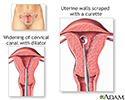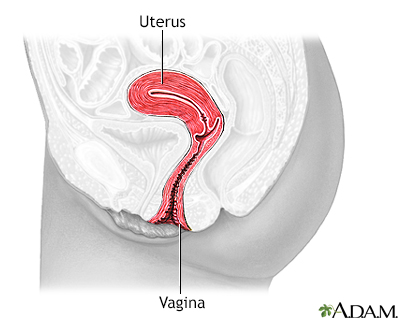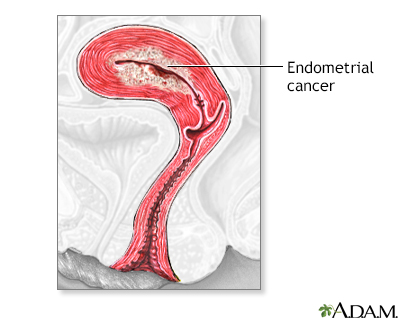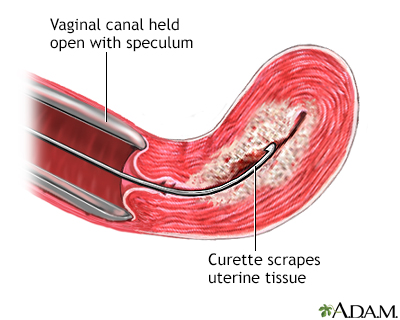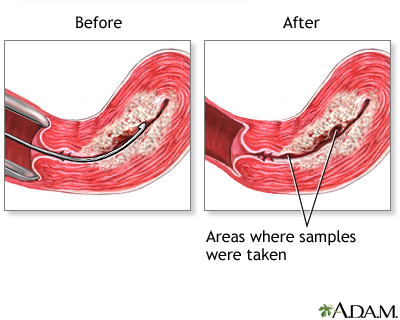
D and C
Dilation and curettage; Uterus scraping; Vaginal bleeding - dilation; Uterine bleeding - dilation; Menopause - dilationD and C (dilation and curettage) is a procedure to scrape and collect the tissue (endometrium) from inside the uterus.
- Dilation (D) is a widening of the cervix to allow instruments into the uterus.
- Curettage (C) is the scraping of tissue from the walls of the uterus.
Description
D and C, also called uterine scraping, may be performed in the hospital or in a clinic while you are under general or local anesthesia.
General
General anesthesia is treatment with certain medicines that puts you into a deep sleep so you do not feel pain during surgery. After you receive the...
Read Article Now Book Mark ArticleThe health care provider will insert an instrument called a speculum into the vagina. This holds the vaginal canal open. Numbing medicine may be applied to the opening to the uterus (cervix).
Cervix
The cervix is the lower end of the womb (uterus). It is at the top of the vagina. It is about 2. 5 to 3. 5 centimeters (1 to 1. 3 inches) long. Th...

The cervical canal is widened, and a curette (a metal loop on the end of a long, thin handle) is passed through the opening into the uterus cavity. The provider gently scrapes the inner layer of tissue, called the endometrium. Alternatively, a suction curette may be used to remove endometrial tissue. The tissue is collected for examination.
Why the Procedure Is Performed
This procedure may be done to:
- Diagnose or rule out conditions such as uterine cancer
Uterine cancer
Endometrial cancer is cancer that starts in the endometrium, the lining of the uterus (womb).
 ImageRead Article Now Book Mark Article
ImageRead Article Now Book Mark Article - Remove tissue after a miscarriage
Miscarriage
A miscarriage is the spontaneous loss of a fetus before the 20th week of pregnancy. Pregnancy losses after the 20th week are called stillbirths. Mi...
 ImageRead Article Now Book Mark Article
ImageRead Article Now Book Mark Article - Treat heavy menstrual bleeding, irregular periods, or bleeding between periods
Bleeding between periods
This article discusses vaginal bleeding that occurs between a woman's monthly menstrual periods. Such bleeding may be called "intermenstrual bleedin...
 ImageRead Article Now Book Mark Article
ImageRead Article Now Book Mark Article - Perform a therapeutic or elective abortion
Your provider may also recommend a D and C if you have:
- Abnormal bleeding while you are on hormone replacement therapy
- An embedded intrauterine device (IUD)
IUD
Your choice of a birth control method depends on a number of factors, including your health, how often you have sexual intercourse, and whether or no...
 ImageRead Article Now Book Mark Article
ImageRead Article Now Book Mark Article - Bleeding after menopause
- Endometrial polyps (small lumps of tissue on the endometrium)
- Thickening of the uterus
This list may not include all possible reasons for a D and C.
Risks
Risks related to D and C include:
- Puncture of the uterus
- Scarring of the uterine lining (Asherman syndrome, may lead to infertility later)
Asherman syndrome
Asherman syndrome is the formation of scar tissue in the uterine cavity. The problem most often develops after uterine surgery.
 ImageRead Article Now Book Mark Article
ImageRead Article Now Book Mark ArticleInfertility
Infertility means you cannot get pregnant (conceive). There are 2 types of infertility:Primary infertility refers to couples who have not become preg...
 ImageRead Article Now Book Mark Article
ImageRead Article Now Book Mark Article - Tear of the cervix
Risks due to anesthesia include:
- Reactions to medicines
-
Problems breathing
Problems breathing
Breathing difficulty may involve:Difficult breathing Uncomfortable breathingFeeling like you are not getting enough air
 ImageRead Article Now Book Mark Article
ImageRead Article Now Book Mark Article
Risks of any surgery include:
- Bleeding
- Infection
After the Procedure
The D and C procedure has few risks. It can provide relief from bleeding and can help diagnose cancer and other diseases.
You may return to your normal activities as soon as you feel better, possibly even the same day.
You may have vaginal bleeding, pelvic cramps, and back pain for a few days after the procedure. You can usually manage pain well with medicines. Avoid using tampons and having sexual intercourse for 1 to 2 weeks after the procedure.
References
Bulun SE. Physiology and pathology of the female reproductive axis. In: Melmed S, Auchus RJ, Goldfine AB, Koenig RJ, Rosen CJ, eds. Williams Textbook of Endocrinology. 14th ed. Philadelphia, PA: Elsevier; 2020:chap 17.
Ryntz T, Lobo RA. Abnormal uterine bleeding: etiology and management of acute and chronic excessive bleeding. In: Gershenson DM, Lentz GM, Valea FA, Lobo RA, eds. Comprehensive Gynecology. 8th ed. Philadelphia, PA: Elsevier; 2022:chap 26.
Williams VL, Thomas S. Dilation and curettage. In: Fowler GC, ed. Pfenninger and Fowler's Procedures for Primary Care. 4th ed. Philadelphia, PA: Elsevier; 2020:chap 162.
-
D and C - illustration
D and C (dilatation and curettage) is a procedure in which the vaginal canal is held open with a speculum and the cervix is dilated with a metal rod. A curette is then passed through the cervical canal into the uterine cavity where endometrial tissue is scraped away and collected for examination.
D and C
illustration
-
D and C - series
Presentation
-
D and C - illustration
D and C (dilatation and curettage) is a procedure in which the vaginal canal is held open with a speculum and the cervix is dilated with a metal rod. A curette is then passed through the cervical canal into the uterine cavity where endometrial tissue is scraped away and collected for examination.
D and C
illustration
-
D and C - series
Presentation
Review Date: 4/16/2024
Reviewed By: John D. Jacobson, MD, Professor Emeritus, Department of Obstetrics and Gynecology, Loma Linda University School of Medicine, Loma Linda, CA. Also reviewed by David C. Dugdale, MD, Medical Director, Brenda Conaway, Editorial Director, and the A.D.A.M. Editorial team.

